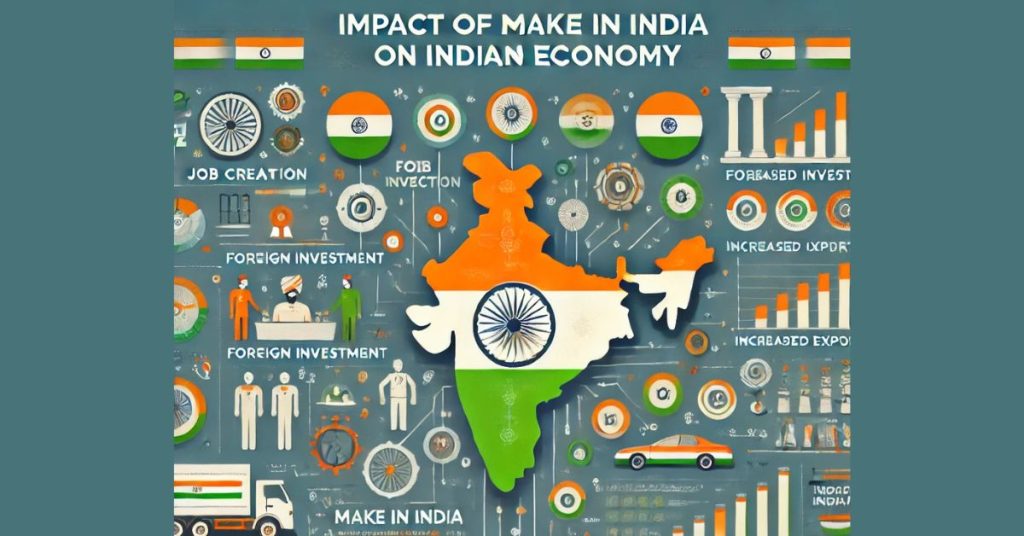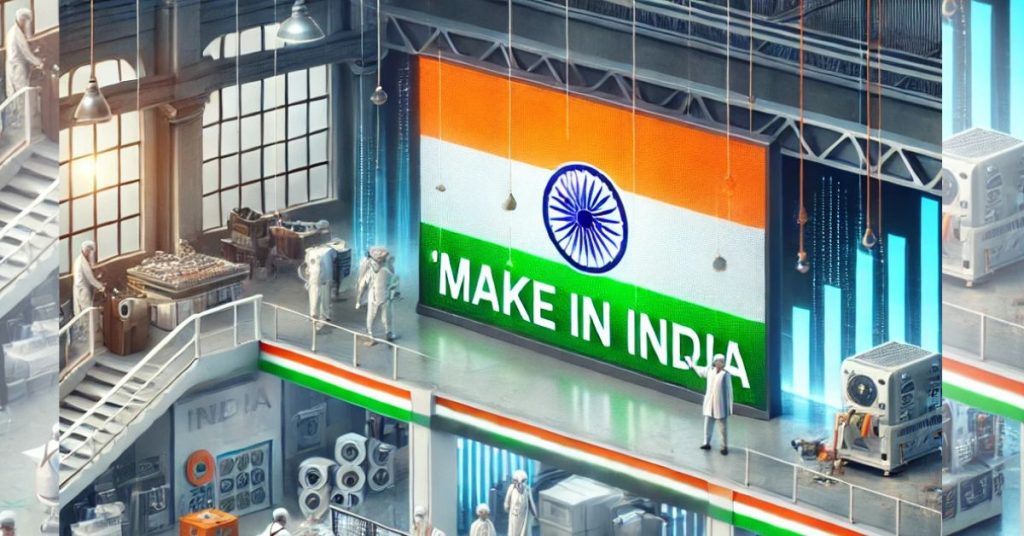“Make in India” is a major campaign started by the Indian government in 2014. The main goal of this campaign is to increase manufacturing in India and reduce dependence on imports. It encourages both Indian and foreign companies to set up factories in the country. This helps in creating jobs, boosting the economy, and making India self-reliant in different industries.
The campaign focuses on various sectors, such as automobiles, textiles, electronics, defense, and many others. It aims to make India a global manufacturing hub, bringing more investment into the country. We will understand how “Make in India” has affected the Indian economy, what benefits it has brought, the challenges it faces, and what the future holds.
Increase in Manufacturing Sector
Before the “Make in India” campaign, India depended a lot on other countries for products like mobile phones, machinery, and defense equipment. Most of these products were imported, which meant that a large amount of money went out of the country.
With the launch of “Make in India,” the government encouraged companies to manufacture these products in India itself. This has led to the growth of many industries. Big international companies like Apple, Samsung, and Tesla have set up factories in India. This has not only reduced dependence on imports but has also created new business opportunities.
The increase in manufacturing has helped India save money, create jobs, and grow the economy.
More Job Opportunities
One of the biggest benefits of “Make in India” is the creation of jobs. Since more industries and factories are being set up, there is a higher demand for workers.
Many people in India were unemployed or had to move to other countries for jobs. With the growth of local industries, both skilled and unskilled workers have found employment in different fields.
For example, the automobile and electronics industries have hired thousands of engineers, technicians, and factory workers. Similarly, the textile industry has provided jobs to millions of people, especially in rural areas.
Apart from direct jobs, new businesses have also started to support manufacturing companies. These businesses provide raw materials, transport goods, and offer various services. This has further increased employment in the country.
Increase in Foreign Investment
Foreign investment is very important for the economic growth of a country. It brings money, technology, and expertise, which help industries grow faster.
“Make in India” has made India an attractive destination for foreign investors. The government has made it easier for companies from other countries to set up businesses here. As a result, big companies from the USA, Japan, Germany, and South Korea have invested in India’s manufacturing sector.
Foreign investments have helped Indian businesses improve their production quality, develop new technologies, and compete in the global market. This has made India one of the top countries for foreign direct investment (FDI).
Better Infrastructure
For industries to grow, good infrastructure is necessary. Infrastructure includes roads, railways, electricity, water supply, and other facilities that help businesses function smoothly.
The Indian government has launched several projects to improve infrastructure under the “Make in India” initiative. For example:
- The Delhi-Mumbai Industrial Corridor (DMIC) – A project that connects major industrial cities with high-speed transport networks.
- Bharatmala Project – A highway development project to improve road connectivity.
- Smart Cities Mission – A project to develop modern cities with advanced facilities.
These projects have made it easier for businesses to transport goods, set up factories, and operate efficiently. Better infrastructure has reduced costs and made India a more attractive place for industries.
Reduced Dependence on Imports
Before “Make in India,” India imported a lot of goods from other countries, especially China. These imports included mobile phones, electronic items, and even defense equipment. Since imports require payment in foreign currency, they increased India’s trade deficit and weakened the value of the Indian Rupee.
With the growth of local manufacturing, India has reduced its dependence on foreign products. For example:
- Many mobile phone brands like Xiaomi, Samsung, and Apple now manufacture their products in India.
- Indian companies have started producing more automobiles, reducing the need to import cars and auto parts.
- The defense sector has also started producing its own weapons and equipment instead of buying from other countries.
By reducing imports, India has saved money, strengthened its economy, and made its currency stronger.
Increase in Exports
With more production in India, the country has also started exporting more goods to other countries. Exports bring foreign currency into India, which helps in economic growth.
Several industries have seen an increase in exports, including:
- Textiles – India is one of the largest producers of cotton and garments. Many countries buy clothes made in India.
- Pharmaceuticals – Indian medicines are exported to many countries because they are high quality and affordable.
- Automobiles – India exports cars, bikes, and auto parts to many countries.
The government has signed trade agreements with other nations to promote Indian goods in international markets. This has helped Indian businesses grow and compete with foreign companies.
Support for Startups and Small Businesses
Apart from large industries, the “Make in India” campaign has also helped small businesses and startups. The government has introduced special programs to support new businesses with loans, tax benefits, and other facilities.
Many Indian startups have developed innovative products in different sectors such as:
- Technology – Indian companies are now producing software, mobile apps, and artificial intelligence solutions.
- Healthcare – Startups are developing medical equipment and medicines.
- Renewable Energy – Companies are working on solar and wind energy solutions.
By supporting startups and small businesses, the government has encouraged innovation and job creation. This has made India a hub for new ideas and entrepreneurship.
Challenges Faced by Make in India
While “Make in India” has been successful in many ways, it still faces some challenges:
- Lack of Skilled Workers – Many industries require highly skilled employees, but India needs better training programs to develop these skills.
- Complicated Rules and Regulations – Even though business regulations have improved, some companies still face difficulties in starting and running businesses.
- Infrastructure Issues – While major cities have good infrastructure, many rural areas still lack proper roads, electricity, and industrial facilities.
- Competition from Other Countries – Countries like China, Vietnam, and Bangladesh offer cheaper labor and better facilities, which makes them tough competitors.
The government is working on solving these problems by introducing better policies, training programs, and improving infrastructure.
Future of Make in India
Despite the challenges, the future of “Make in India” looks very promising. The government is continuously making efforts to attract more investments and improve the manufacturing sector. New initiatives such as “Atmanirbhar Bharat” (Self-Reliant India) are being introduced to make India more independent in production.
With the rise of new technologies like artificial intelligence, automation, and renewable energy, India’s manufacturing sector is expected to grow even more. The focus on sustainability and green energy will also make Indian industries more competitive globally.
If India continues to improve infrastructure, develop skills, and make business-friendly policies, it can become one of the top manufacturing countries in the world.
Conclusion
The “Make in India” campaign has had a strong impact on the Indian economy. It has helped increase manufacturing, create jobs, attract foreign investments, and improve infrastructure. It has also reduced imports, boosted exports, and supported startups.
While there are challenges, the initiative has put India on the path to becoming a global manufacturing powerhouse. With continuous efforts from the government, businesses, and the people, India can achieve self-reliance and strong economic growth in the coming years.
Also Read:
Who is Make in India Brand Ambassador?
Public Procurement Preference to Make in India Order 2017
Frequently asked questions
What is the main goal of the Make in India campaign?
The main goal of “Make in India” is to boost manufacturing, create jobs, and attract foreign investments. It encourages companies to set up factories in India, reducing imports and making the country self-reliant in various industries like automobiles, electronics, defense, and textiles.
How has Make in India helped in job creation?
By promoting manufacturing, “Make in India” has created jobs for skilled and unskilled workers. Industries like automobiles, electronics, and textiles have expanded, hiring engineers, technicians, and factory workers. Small businesses and startups have also benefited, leading to more employment opportunities across the country.
How has Make in India impacted foreign investment?
The campaign has made India an attractive destination for global companies. The government introduced business-friendly policies, allowing 100% FDI in many sectors. As a result, big companies like Apple, Samsung, and Tesla have invested in India, boosting economic growth and technological advancements.
What are the challenges faced by Make in India?
Some challenges include a shortage of skilled workers, complex regulations, and infrastructure issues in rural areas. India also faces tough competition from countries like China and Vietnam. The government is working to improve ease of doing business and develop industrial facilities.
How has Make in India reduced dependence on imports?
Before the campaign, India imported many products, including electronics and defense equipment. With local manufacturing increasing, India now produces mobile phones, automobiles, and weapons domestically. This has reduced foreign dependence, saved money, and strengthened the Indian economy.




